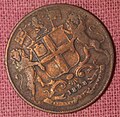 Painting of Mirza Ghalib in Ghalib Museum | |
 | |
| Established | 22 February 1969 |
|---|---|
| Location | Nizamuddin (West) |
| Coordinates | 28°35′29″N77°14′36″E / 28.591460°N 77.243253°E |
| Type | Memorial |
| Key holdings | Coins of Mughal Era, Handwritten Poems/letters of Ghalib |
| Collections | Paintings, Calligraphy, Handwritten specimens |
| Owner | Ghalib Academy, New Delhi |
| Public transit access | Jawahar Lal Nehru Stadium Metro |
| Website | www |
Mirza Ghalib Museum, New Delhi is a museum on the life and times of the 18th century Urdu poet Mirza Ghalib, [1] under the aegis of the Ghalib Academy, New Delhi. The museum is situated in the vicinity of the tomb of the 13th century Sufi saint Khwaja Nizamuddin.

























